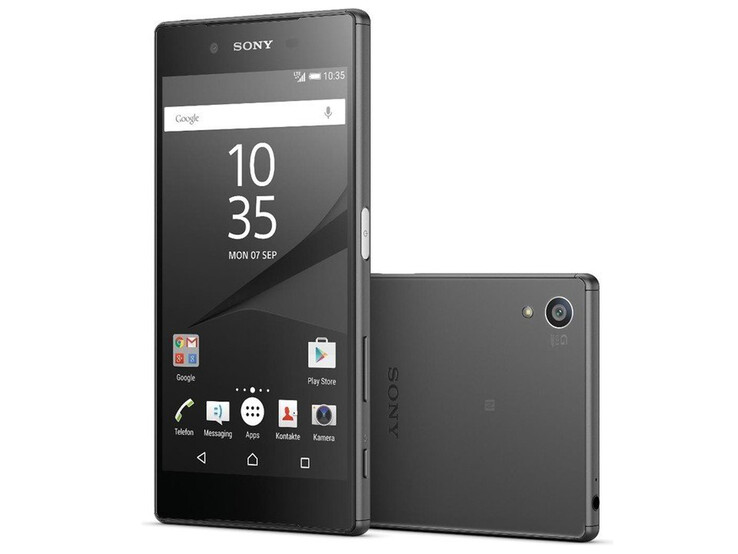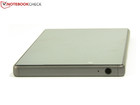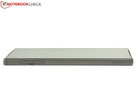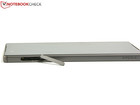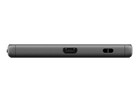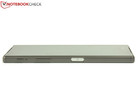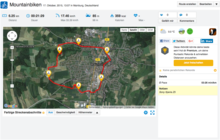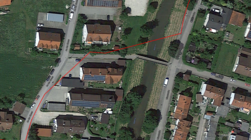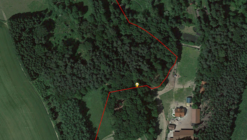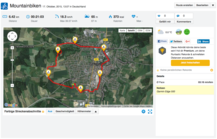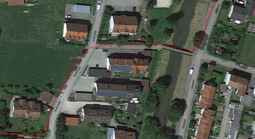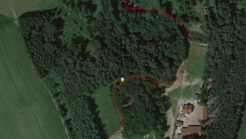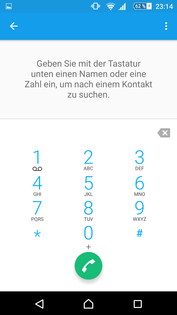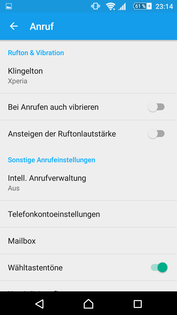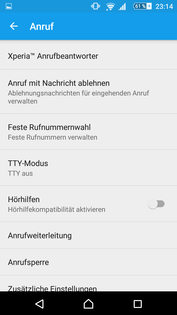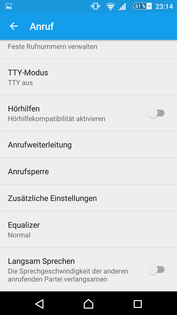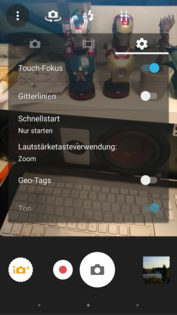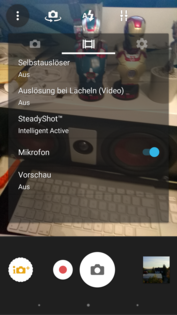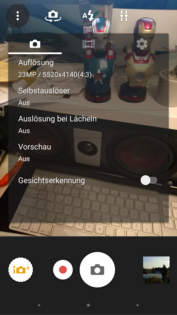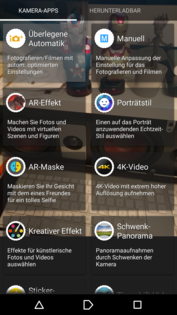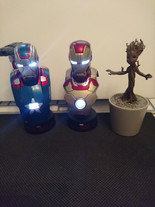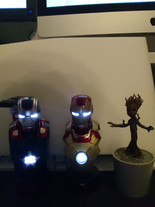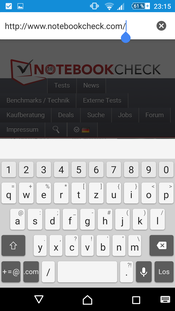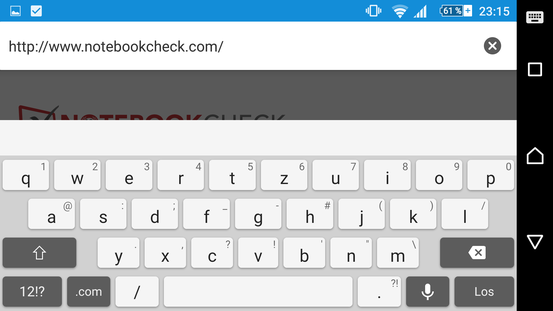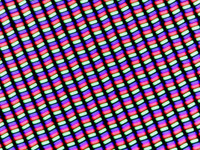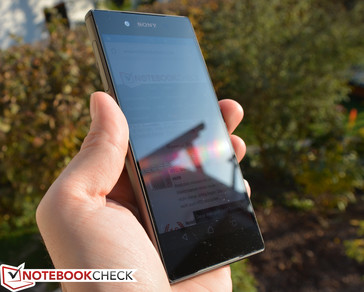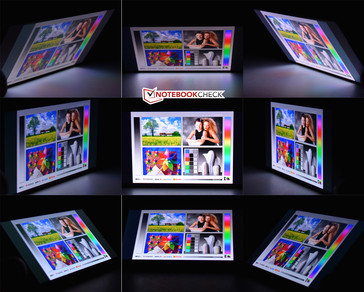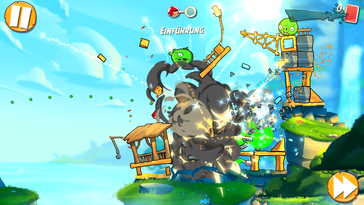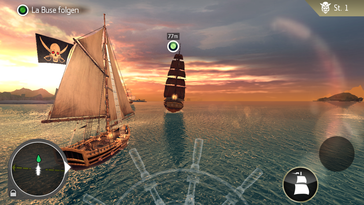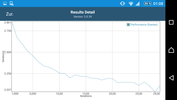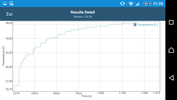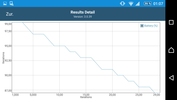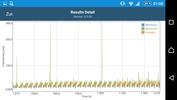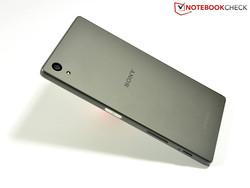Sony Xperia Z5 Smartphone Review
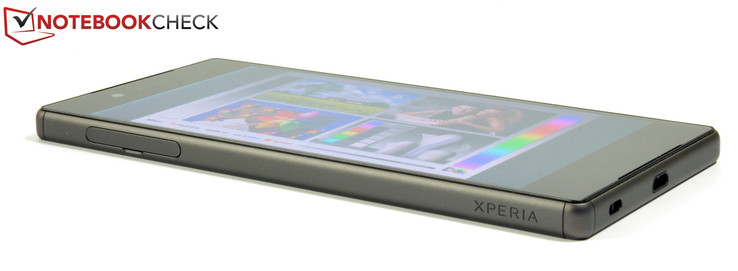
For the original German review, see here.
The Sony Xperia Z5 follows around half a year after the Sony Xperia Z3+ and is once again just a small update. As a flagship device, it comes with a lot of features and does not disappoint in terms of cameras, wireless modules and SoC, either. It is still equipped with the fast 64-bit processor Snapdragon 810 and the RRP is 699 Euros (~$744).
Strong competitors in the high-end range are, besides the predecessor Sony Xperia Z3+, the Apple iPhone 6S Plus, the Huawei Mate S as well as the Samsung Galaxy S6 Edge+.
Case
Compared to the predecessor Sony Xperia Z3+, all the dimensions of the Xperia Z5 are now slightly bigger by 0.1 mm, so it is still pretty thin at 7.3 mm. The Z5 is once again also supported against dust and humidity (IP68), which is pretty unique among the rivals; only the Huawei Mate S at least features a Nano coating against spill water. The design is a bit more angular than before, but it still feels good in the hand. As expected, Sony once again uses a combination of metal and glass. The latter is matted at the back this time and looks very noble.
There is no criticism for the gaps of our review unit, so the manufacturer actually listened to us and improved the device. Our twisting attempts are not successful and there is no creaking, either. Only a lot of pressure on the screen will create ripples, but the back is even less susceptible. The battery is integrated and the slots for the Nano-SIM and the microSD are well integrated. The tray for the Nano-SIM and the microSD on the other hand is very delicate and not stable. Both cards are also located behind each other, so a replacement of the microSD is unnecessarily tricky. The solution of the Sony Xperia Z5 Compact, where both slots are next to each other, is more comfortable.
Besides black, the Z5 is also available in white, gold, green or the black James Bond Edition. The latter only differs from our black review unit by a couple of additions: a Bond Xperia theme, an exclusive movie trailer, 007 bonus material as well as a limited Spectre key chain.
Connectivity
Sony changed the button design and the layout of the Z5 similar to the Xperia Z5 Compact. The power button is now oval and slightly depressed at the right side due to the combined function as a fingerprint scanner, which works very reliably. The new position of the volume rocker is not perfect; it is now between the power button and the camera trigger at the bottom right, which does affect the ergonomics noticeably. We liked the pressure point and the travel of the physical buttons though. Similar to the predecessor Sony Xperia Z3 Plus, the slots for microSD and Nano-SIM cards are hidden underneath a metal cover on the left side. But you should be careful, because the plastic tray for the two cards is very fragile. A replacement on the fly is also not a good idea because you cannot use the SIM card during this time, either.
The Micro-USB port 2.0 can be used to transfer files and charge the smartphone. If you connect the device with a PC, you can directly download Sony’s PC Companion software from the manufacturer’s homepage if you want to. OTG is only possible after you activate it in the settings with the USB connection, so you can attach external input devices or storage devices. MHL 3.0 is supported as well. Wireless data transfers are possible via DLNA, Miracast or LDAC. The microSD-slot can be used for storage expansions by up to 200 GB, and App2SD is no problem with the majority of apps. The 3.5 mm stereo jack also provides additional signals for noise cancelling in combination with compatible headsets, and the headset works as an antenna for the integrated FM radio.
Software
Sony ships the Xperia Z5 with Android 5.1.1 Lollipop in combination with its own Xperia user interface, which does not change the Android OS a lot. The whole Sony Xperia Z5 series will get an update to Android 6.0 Marshmallow, which was released in October, soon.
Sony once again installs some services and apps like the PlayStation 4 connectivity including Remote Play feature or the fitness app Lifelog. Most of them can easily be deleted as well. More information about the software is available in the review of the Sony Xperia Z5 Compact.
Communication & GPS
Besides Bluetooth 4.1, the Sony Xperia Z5 also supports NFC as well as ANT+. The modern Wi-Fi module supports the IEEE-802.11 ac standard and manages a good and stable signal quality. We still got around three out of four bars with a distance of 10 meters to the router and through three walls. Mobile Internet connections can be established via quad-band GSM, quad-band UMTS (HSPA+ up to 42.2 Mbps) as well as LTE Cat. 6 (up to 300 Mbps) with thirteen frequencies. The reception was good during our review period and did not cause any criticism.
Locating the smartphone is possible via A-GPS module including GLONASS as well as BeiDou support and the performance is very good. A connection to the satellites was established after around one minute indoors with an accuracy of 11 meters, which dropped to 3 meters outdoors. We also checked the accuracy in a comparison with the professional navigation device Garmin Edge 500 on a bicycle ride. Our review sample only deviated by around 130 meters, which is caused by tricky sections like the bridge crossing or the forest. The overall result is good, but the rival Apple iPhone 6S Plus manages an even better performance.
Telephone & Voice Quality
The voice quality of the Sony Xperia Z5 is almost impeccable, which was confirmed by other people in some test calls. The hands-free feature via speaker also works very well and is sufficiently loud. The provided stereo headset also deserves praise. The simple phone app is very easy to use and offers all the common features like favorites, caller groups and a mailbox.
Cameras & Multimedia
Sony uses identical camera modules for the current Xperia series including the Z5 and the siblings Z5 Compact and Z5 Premium. According to the manufacturer, it is the best smartphone camera in the world. The main camera uses the 23 MP sensor (1/2.3 inch) Sony Exmor RS and a 24 mm wide angle G lens. The integrated picture processing engine BIONZ is supposed to improve colors and reduce artifacts as well as picture noise. The hybrid autofocus (0.03 s) is actually very fast but only manages a sharp picture when the lighting is good or you use the LED flash. The camera can also be quickly launched via trigger from standby.
A maximum ISO value of 12800 should also ensure good results in low-light situations. The first five steps of optical zoom can be used almost without loss of information. Our quality comparison with some rivals and a DSLR shows that the Xperia Z5 takes very decent pictures under good lighting conditions. Videos can be recorded in Ultra-HD with 3840x2160 pixels at 30 fps. The temperature issues of the predecessor, which had a warning message when you launched the camera app, seem to be resolved and we did not experience any problems during the review period.
The front sensor uses a 5 MP sensor and a 25 mm wide angle lens. Videos can be recorded in Full HD. The results are actually quite good when the lighting is sufficient, but low-light pictures suffer from visible picture noise, are not very sharp and the colors could be better as well. Still, a decent performance by the review unit.
Accessories
Sony ships the Xperia Z5 with a modular USB power adaptor and a stereo headset. Sony also offers optional dedicated accessories like the Smart Style Cover SCR42 for 39 Euros (~$41) in matching colors, the noise-cancelling headset MDR-NC750 with high-res support for around 70 Euros (~$74) or the Quick Charger UCH10 for around 30 Euros (~$31).
Warranty
The standard warranty period is 24 months, but the power adaptor and the headset are only covered for 6 months.
Input Devices & Handling
The capacitive touchscreen is very precise up into the peripheral areas and the surface provides good gliding capabilities for the fingers. The smartphone has a glove mode and recognizes up to ten inputs simultaneously; multitouch gestures are no problem, either. The new fingerprint scanner requires an initial push but convinces with a very fast and reliable operation after that. Up to five different fingerprints can be stored, but the scanner can only be used to unlock the device at this point. We would like to see an update with more features like a purchase confirmation for the Play Store, similar to the iPhone 6S Plus.
The virtual QWERTY keyboard is very simple and can be, similar to the Xperia Z3 Plus, adjusted. More information about the keyboard and the physical buttons is available in the review of the Sony Xperia Z5 Compact.
Display
The Sony Xperia Z5 has a 5.2-inch FHD screen with 1920x1080 pixels and a 16:9 screen ratio. This results in a very good pixel density of 424 PPI, which does not differ from the predecessor Xperia Z3 Plus. The other competitors Apple iPhone 6S Plus and Huawei Mate S use this resolution as well, only the Samsung Galaxy S6 Edge+ has a slightly higher resolution of 2560x1440 pixels. The panel of our review sample is very sharp nonetheless. The maximum brightness of the Xperia Z5 is pretty impressive at 669 cd/m², which surpasses the already very bright Xperia Z3 Plus by another 49 cd/m². The advantage over the other competitors is significant, but the brightness distribution could be better than 85%. The subpixels that are responsible for the primary colors do not reveal any issues and are clearly separated, so fonts and angled edges are very sharp.
| |||||||||||||||||||||||||
Brightness Distribution: 85 %
Center on Battery: 669 cd/m²
Contrast: 984:1 (Black: 0.68 cd/m²)
ΔE ColorChecker Calman: 7.96 | ∀{0.5-29.43 Ø4.78}
ΔE Greyscale Calman: 10.95 | ∀{0.09-98 Ø5}
Gamma: 2.61
CCT: 7402 K
| Sony Xperia Z5 Adreno 430, 810 MSM8994, 32 GB eMMC Flash | Apple iPhone 6S Plus A9 / PowerVR GT7600, A9, Apple AP0064K (iPhone NVMe) | Sony Xperia Z3+ Adreno 430, 810 MSM8994, 32 GB eMMC Flash | Huawei Mate S Mali-T628 MP4, Kirin 935, 32 GB eMMC Flash | Samsung Galaxy S6 Edge+ Mali-T760 MP8, Exynos 7420, 32 GB UFS 2.0 Flash | |
|---|---|---|---|---|---|
| Screen | 24% | 4% | -2% | 12% | |
| Brightness middle (cd/m²) | 669 | 583 -13% | 605 -10% | 352 -47% | 335.7 -50% |
| Brightness (cd/m²) | 624 | 560 -10% | 601 -4% | 350 -44% | 332 -47% |
| Brightness Distribution (%) | 85 | 91 7% | 92 8% | 87 2% | 89 5% |
| Black Level * (cd/m²) | 0.68 | 0.46 32% | 0.53 22% | ||
| Contrast (:1) | 984 | 1267 29% | 1142 16% | ||
| Colorchecker dE 2000 * | 7.96 | 3.55 55% | 9.24 -16% | 4.95 38% | 2.33 71% |
| Greyscale dE 2000 * | 10.95 | 3.88 65% | 10.01 9% | 6.54 40% | 2.15 80% |
| Gamma | 2.61 84% | 2.2 100% | 2.22 99% | 2.27 97% | 2.15 102% |
| CCT | 7402 88% | 7280 89% | 10343 63% | 6943 94% | 6184 105% |
| Color Space (Percent of AdobeRGB 1998) (%) | 59.05 | 65.65 | |||
| Color Space (Percent of sRGB) (%) | 92.8 | 97.1 |
* ... smaller is better
The black value is a bit too high within the comparison at 0.68 cd/m², but you still get a decent contrast ratio of 984:1 thanks to the extremely high luminance. The rivals, however, manage even higher contrast ratios.
The colors are slightly distorted with the factory settings. Similar to the predecessor Xperia Z3 Plus, we can see a blue cast in the grayscale, and the colors deviate heavily from their respective ideal values as well. The situation is much improved when you use the manual white balance – even though the Samsung Galaxy S6 Edge+ still has a clear advantage. The sRGB color space is covered by around 96% according to the software CalMAN. However, the latter only uses a 2D measurement, so the result should only be seen as an indicator. Subjectively, we like the pretty rich blacks – especially at adjusted brightness levels – as well as vivid and natural colors.
The outdoor capabilities benefit from the high luminance of the Sony Xperia Z5. The visibility is very good when you can avoid direct reflections on the very glossy display. Based on our observations, the Z5 does not suffer from the temperature-related brightness reduction that we experienced during the review of the Xperia Z3 Plus. All in all, a very good performance.
The IPS technology ensures good viewing angles and the colors are not affected even from very flat angles, and the brightness is just slightly reduced.
Performance
Just like the Xperia Z3 Plus, the Sony Xperia Z5 is equipped with the Qualcomm Snapdragon 810 MSM8994 octa-core SoC (64-bit) running at 2 GHz. The graphics are handled by the integrated Adreno 430 GPU. Both siblings Xperia Z5 Compact and Xperia Z5 Premium use this powerful processor as well, which is supported by 3 GB RAM. The temperature management is better this time, so the review unit has an advantage over the predecessor in almost every benchmark. We did not notice any stutters in practice, either. The performance is very good within our comparison group and can usually beat the rivals. Only the Apple iPhone 6S Plus and the Samsung Galaxy S6 Edge+ are often even faster.
| Geekbench 3 | |
| 64 Bit Single-Core Score (sort by value) | |
| Sony Xperia Z5 | |
| Apple iPhone 6S Plus | |
| Sony Xperia Z3+ | |
| Huawei Mate S | |
| Samsung Galaxy S6 Edge+ | |
| 64 Bit Multi-Core Score (sort by value) | |
| Sony Xperia Z5 | |
| Apple iPhone 6S Plus | |
| Sony Xperia Z3+ | |
| Huawei Mate S | |
| Samsung Galaxy S6 Edge+ | |
| GFXBench (DX / GLBenchmark) 2.7 | |
| T-Rex Onscreen (sort by value) | |
| Sony Xperia Z5 | |
| Apple iPhone 6S Plus | |
| Sony Xperia Z3+ | |
| Huawei Mate S | |
| 1920x1080 T-Rex Offscreen (sort by value) | |
| Sony Xperia Z5 | |
| Apple iPhone 6S Plus | |
| Sony Xperia Z3+ | |
| Huawei Mate S | |
| GFXBench 3.0 | |
| 1920x1080 1080p Manhattan Offscreen (sort by value) | |
| Sony Xperia Z5 | |
| Apple iPhone 6S Plus | |
| Sony Xperia Z3+ | |
| Huawei Mate S | |
| Samsung Galaxy S6 Edge+ | |
| on screen Manhattan Onscreen OGL (sort by value) | |
| Sony Xperia Z5 | |
| Apple iPhone 6S Plus | |
| Sony Xperia Z3+ | |
| Huawei Mate S | |
| Samsung Galaxy S6 Edge+ | |
| GFXBench 3.1 | |
| 1920x1080 Manhattan ES 3.1 Offscreen (sort by value) | |
| Sony Xperia Z5 | |
| Apple iPhone 6S Plus | |
| Sony Xperia Z3+ | |
| Huawei Mate S | |
| on screen Manhattan ES 3.1 Onscreen (sort by value) | |
| Sony Xperia Z5 | |
| Apple iPhone 6S Plus | |
| Sony Xperia Z3+ | |
| Huawei Mate S | |
| Smartbench 2012 | |
| Gaming Index (sort by value) | |
| Sony Xperia Z5 | |
| Sony Xperia Z3+ | |
| Huawei Mate S | |
| Samsung Galaxy S6 Edge+ | |
| Productivity Index (sort by value) | |
| Sony Xperia Z5 | |
| Sony Xperia Z3+ | |
| Huawei Mate S | |
| Samsung Galaxy S6 Edge+ | |
| Linpack Android / IOS | |
| Single Thread (sort by value) | |
| Sony Xperia Z5 | |
| Apple iPhone 6S Plus | |
| Sony Xperia Z3+ | |
| Huawei Mate S | |
| Multi Thread (sort by value) | |
| Sony Xperia Z5 | |
| Apple iPhone 6S Plus | |
| Sony Xperia Z3+ | |
| Huawei Mate S | |
| AnTuTu v5 - Total Score (sort by value) | |
| Sony Xperia Z5 | |
| Apple iPhone 6S Plus | |
| Sony Xperia Z3+ | |
| Huawei Mate S | |
| Samsung Galaxy S6 Edge+ | |
| PCMark for Android - Work performance score (sort by value) | |
| Sony Xperia Z5 | |
| Sony Xperia Z3+ | |
| Huawei Mate S | |
| Samsung Galaxy S6 Edge+ | |
We performed the browser-based benchmarks with the browser Google Chrome (version 46) and the results are very convincing. Both the Huawei Mate S and the Sony Xperia Z3 Plus in particular usually fall behind, sometimes even the Samsung Galaxy S6 Edge+ does too. Only the Apple iPhone 6S Plus always has a considerable advantage. The subjective browsing experience with the Z5 is still very good thanks to short loading times.
| Sunspider - 1.0 Total Score (sort by value) | |
| Sony Xperia Z5 | |
| Apple iPhone 6S Plus | |
| Sony Xperia Z3+ | |
| Samsung Galaxy S6 Edge+ | |
| Huawei Mate S | |
| Octane V2 - Total Score (sort by value) | |
| Sony Xperia Z5 | |
| Apple iPhone 6S Plus | |
| Sony Xperia Z3+ | |
| Samsung Galaxy S6 Edge+ | |
| Huawei Mate S | |
| Mozilla Kraken 1.1 - Total (sort by value) | |
| Sony Xperia Z5 | |
| Apple iPhone 6S Plus | |
| Sony Xperia Z3+ | |
| Samsung Galaxy S6 Edge+ | |
| Huawei Mate S | |
| Google V8 Ver. 7 - Google V8 Ver. 7 Score (sort by value) | |
| Sony Xperia Z5 | |
| Apple iPhone 6S Plus | |
| Sony Xperia Z3+ | |
| Samsung Galaxy S6 Edge+ | |
| WebXPRT 2015 - Overall (sort by value) | |
| Sony Xperia Z5 | |
| Apple iPhone 6S Plus | |
| Sony Xperia Z3+ | |
| Samsung Galaxy S6 Edge+ | |
| Huawei Mate S | |
| JetStream 1.1 - Total Score (sort by value) | |
| Sony Xperia Z5 | |
| Apple iPhone 6S Plus | |
| Sony Xperia Z3+ | |
| Samsung Galaxy S6 Edge+ | |
| Huawei Mate S | |
* ... smaller is better
The Sony Xperia Z5 is equipped with 32 GB internal storage (net 20.31 GB), which can be expanded by microSD-card (up to 200 GB). It is usually possible to transfer contents to the memory card.
A direct comparison with the predecessor Xperia Z3 Plus shows that the review unit only manages a higher sequential write performance, the other results are sometimes much lower. The Huawei Mate S only has an advantage with small files (read and write), while the Samsung Galaxy S6 Edge+ has a clear advantage in every test. The values suggest that you have to be patient during transfers, but the access times never felt too slow in practice.
| AndroBench 3-5 | |
| Random Write 4KB (sort by value) | |
| Sony Xperia Z5 | |
| Huawei Mate S | |
| Samsung Galaxy S6 Edge+ | |
| Sony Xperia Z3+ | |
| Random Read 4KB (sort by value) | |
| Sony Xperia Z5 | |
| Huawei Mate S | |
| Samsung Galaxy S6 Edge+ | |
| Sony Xperia Z3+ | |
| Sequential Write 256KB (sort by value) | |
| Sony Xperia Z5 | |
| Huawei Mate S | |
| Samsung Galaxy S6 Edge+ | |
| Sony Xperia Z3+ | |
| Sequential Read 256KB (sort by value) | |
| Sony Xperia Z5 | |
| Huawei Mate S | |
| Samsung Galaxy S6 Edge+ | |
| Sony Xperia Z3+ | |
Games
The powerful Qualcomm Adreno 430 GPU provides more than enough performance in all scenarios. There is currently no game in the Play Store that would not run smoothly on the Sony Xperia Z5. We tested the very demanding Assassin’s Creed Pirates as well as the more casual Angry Birds 2, but both titles ran smoothly at the highest settings. The accurate sensors and the precise touchscreen complement the gaming experience. Thanks to PS 4 Remote Play, the Z5 can even be used as a mobile PlayStation 4, although it requires the excellent PlayStation Dualshock 4 Wireless Controller. Both devices also have to use the same Wi-Fi network.
Emissions
Temperature
Because of the hot-headed predecessor Xperia Z3 Plus, we were a bit anxious about the results of the Z5 in this category. But the surface temperatures are actually lower than expected at up to 35.5 °C while idling and up to 38.4 °C under maximum load. The Samsung Galaxy S6 Edge+ and the Apple iPhone 6S Plus can even get much warmer. Subjectively, the review unit was never inconveniently hot.
We also checked for throttling of the performance with the GFXBench 3.0 Battery Test. It repeats the T-Rex test thirty times. Contrary to the Sony Xperia Z5 Compact, the performance is already reduced at the start of the test, but the drop is much lower compared to the predecessor at 30%.
(±) The maximum temperature on the upper side is 40 °C / 104 F, compared to the average of 35.2 °C / 95 F, ranging from 21.9 to 247 °C for the class Smartphone.
(+) The bottom heats up to a maximum of 39.4 °C / 103 F, compared to the average of 34 °C / 93 F
(±) In idle usage, the average temperature for the upper side is 32.6 °C / 91 F, compared to the device average of 32.9 °C / 91 F.
Speakers
The stereo speakers at the front of the smartphone are hardly visible and produce a convincing sound. The maximum volume is high, but there are actually no distortions, and you can notice comparatively a lot of bass. Several additional features like the sound enhancers DSEE HX or ClearAudio+ for the frequency balance as well as a comprehensive equalizer are available. Music enthusiasts will probably still want to use an external output device like the corresponding Sony headset. The latter even supports noise cancellation to enjoy rich sound even in louder environments. The provided headset does not support it but still sounds pretty decent.
The creators of the legendary Walkman also equipped the Z5 with support for high-res audio files like FLACs as well as the audio standards A2DP and apt-X via Bluetooth. The Z5 obviously supports Sony's new LDAC technology. It can be used to transfer lossless high-res audio files (LPCM) via Bluetooth to a compatible device. Finally, the 3.5 mm jack meets the high expectations with a noise-free and powerful playback.
Energy Management
Power Consumption
The power consumption of the Xperia Z5 is pretty frugal within the comparison. It is actually one of the most frugal devices while idling (on average) together with the Huawei Mate S. Still, maximum load will increase the consumption to 8.7 Watts due to the powerful SoC and the bright display. The competition is between 15-30% more frugal. The Z5 supports quick charge, but it requires the optional Quick Charger UCH10.
| Off / Standby | |
| Idle | |
| Load |
|
Key:
min: | |
| Sony Xperia Z5 | Sony Xperia Z3+ | Apple iPhone 6S Plus | Huawei Mate S | Samsung Galaxy S6 Edge+ | |
|---|---|---|---|---|---|
| Power Consumption | -10% | 13% | 19% | ||
| Idle Minimum * (Watt) | 0.7 | 0.6 14% | 0.5 29% | 0.6 14% | |
| Idle Average * (Watt) | 1.7 | 2.5 -47% | 1.9 -12% | 1.2 29% | |
| Idle Maximum * (Watt) | 1.8 | 2.7 -50% | 2.2 -22% | 1.6 11% | |
| Load Average * (Watt) | 5.6 | 5.5 2% | 3.2 43% | 4.1 27% | |
| Load Maximum * (Watt) | 8.7 | 6.1 30% | 6.4 26% | 7.4 15% |
* ... smaller is better
Battery Runtime
The Sony Xperia Z5 has a 2900 mAh battery, only the Samsung Galaxy S6 Edge+ (3000 mAh) has an even bigger module. The Apple iPhone 6S Plus and the Huawei Mate S are not far behind with 2750 and 2700 mAh, respectively. This is also the result for the good battery runtimes in comparison. Still, it can only manage a clear advantage over the predecessor Xperia Z3+. Under load, the Z5 is between the Samsung Galaxy S6 Edge+ and the Apple iPhone 6S Plus at the bottom of the ranking. Our practical Wi-Fi test at 150 nits determines a solid runtime of 7:18 hours. Full HD video playback at this luminance is possible for 10 hours. Only the Apple iPhone 6S Plus has more stamina in this scenario. The familiar energy-saving modes from the predecessor like the Ultra Stamina Mode with reduced functionality are still available and can increase the runtime significantly.
| Sony Xperia Z5 Adreno 430, 810 MSM8994, 32 GB eMMC Flash | Apple iPhone 6S Plus A9 / PowerVR GT7600, A9, Apple AP0064K (iPhone NVMe) | Samsung Galaxy S6 Edge+ Mali-T760 MP8, Exynos 7420, 32 GB UFS 2.0 Flash | Huawei Mate S Mali-T628 MP4, Kirin 935, 32 GB eMMC Flash | Sony Xperia Z3+ Adreno 430, 810 MSM8994, 32 GB eMMC Flash | Sony Xperia Z5 Compact Adreno 430, 810 MSM8994, 32 GB eMMC Flash | |
|---|---|---|---|---|---|---|
| Battery runtime | 7% | 2% | 6% | 2% | 9% | |
| Reader / Idle (h) | 27.8 | 27.6 -1% | 24.3 -13% | 18.7 -33% | 28.2 1% | 37.5 35% |
| H.264 (h) | 10 | 11.9 19% | 9.5 -5% | 8.8 -12% | 8.8 -12% | |
| WiFi v1.3 (h) | 7.3 | 8.6 18% | 8.4 15% | 9.6 32% | 6.5 -11% | 7.3 0% |
| Load (h) | 3.6 | 3.3 -8% | 3.7 3% | 4.7 31% | 4.7 31% | 4 11% |
Pros
Cons
Verdict
After the review of the Sony Xperia Z3+ we wanted a very good flagship device from Sony that is actually ready for the market. Our wish was granted by the Japanese developers. How did they pull it off? Well, they eliminated the biggest issues, starting with the hot temperatures. The review unit has a much more balanced temperature management and is cooler. The build quality of the metal chassis is once again on the expected high level. Even quick pictures under good lighting conditions are no problem. Sony also does a lot of things right with the Z5: The display can almost completely convince us as long as you adjust the white balance. The main camera also takes really good pictures and does not have to hide behind other high-end smartphones.
Thanks to the big storage with the easy expandability, you can also record high-resolution videos. Ambitious agents also benefit from the comprehensive connectivity with a great signal quality and usable GPS as well as the quick and reliable fingerprint scanner with perfect ergonomics. Spill water and dust resistance also ensure the outdoor usability when the weather gets worse. The bright and high-contrast FHD display helps as well. Entertainment fans will appreciate the good sound and the high gaming performance, so even long flights are no problem. Thanks to the long runtimes, you do not really need a power adaptor. The intuitive handling as well as the current software and firmware complement the very good overall impression.
The Sony Xperia Z5 really deserves the very good rating and therefore our purchase recommendation, because there are no real drawbacks. You get a high-end flair combined with high-end components and good performance figures.
If you are not scared of the high price and you are not allergic to glass and metal, then it is really hard to ignore the Sony Xperia Z5 when you are looking for a flagship smartphone.
Sony Xperia Z5
- 11/13/2015 v4 (old)
Michael Moser




